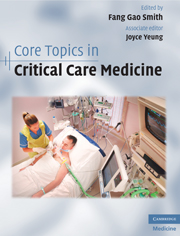14 results
Core Topics in Critical Care Medicine - Half title page
-
- Book:
- Core Topics in Critical Care Medicine
- Published online:
- 06 July 2010
- Print publication:
- 22 April 2010, pp i-ii
-
- Chapter
- Export citation
Section II: - Systemic disorders and management
-
- Book:
- Core Topics in Critical Care Medicine
- Published online:
- 06 July 2010
- Print publication:
- 22 April 2010, pp 99-176
-
- Chapter
- Export citation
Section III: - Organ dysfunction and management
-
- Book:
- Core Topics in Critical Care Medicine
- Published online:
- 06 July 2010
- Print publication:
- 22 April 2010, pp 177-368
-
- Chapter
- Export citation
Section I: - Specific features of critical care medicine
-
- Book:
- Core Topics in Critical Care Medicine
- Published online:
- 06 July 2010
- Print publication:
- 22 April 2010, pp 1-98
-
- Chapter
- Export citation

Core Topics in Critical Care Medicine
-
- Published online:
- 06 July 2010
- Print publication:
- 22 April 2010
Section IV: - Examinations
-
- Book:
- Core Topics in Critical Care Medicine
- Published online:
- 06 July 2010
- Print publication:
- 22 April 2010, pp 369-379
-
- Chapter
- Export citation
Index
-
- Book:
- Core Topics in Critical Care Medicine
- Published online:
- 06 July 2010
- Print publication:
- 22 April 2010, pp 380-391
-
- Chapter
- Export citation
Copyright page
-
- Book:
- Core Topics in Critical Care Medicine
- Published online:
- 06 July 2010
- Print publication:
- 22 April 2010, pp iv-iv
-
- Chapter
- Export citation
Abbreviations
-
- Book:
- Core Topics in Critical Care Medicine
- Published online:
- 06 July 2010
- Print publication:
- 22 April 2010, pp xiii-xvi
-
- Chapter
- Export citation
Preface
-
- Book:
- Core Topics in Critical Care Medicine
- Published online:
- 06 July 2010
- Print publication:
- 22 April 2010, pp xi-xi
-
- Chapter
- Export citation
Core Topics in Critical Care Medicine - Title page
-
-
- Book:
- Core Topics in Critical Care Medicine
- Published online:
- 06 July 2010
- Print publication:
- 22 April 2010, pp iii-iii
-
- Chapter
- Export citation
Acknowledgements
-
- Book:
- Core Topics in Critical Care Medicine
- Published online:
- 06 July 2010
- Print publication:
- 22 April 2010, pp xii-xii
-
- Chapter
- Export citation
Contributors
-
-
- Book:
- Core Topics in Critical Care Medicine
- Published online:
- 06 July 2010
- Print publication:
- 22 April 2010, pp vii-viii
-
- Chapter
- Export citation
Contents
-
- Book:
- Core Topics in Critical Care Medicine
- Published online:
- 06 July 2010
- Print publication:
- 22 April 2010, pp v-vi
-
- Chapter
- Export citation



